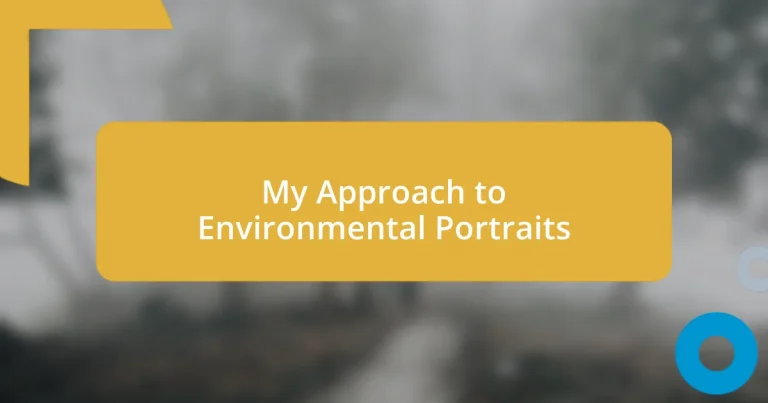Key takeaways:
- Environmental portraits effectively capture the connection between the subject and their surroundings, enhancing emotional storytelling.
- Choosing significant locations and incorporating natural elements can elevate portraits by adding depth and authenticity to the narrative.
- Utilizing natural light, effective composition techniques, and thoughtful post-processing can transform photographs into compelling visual stories.
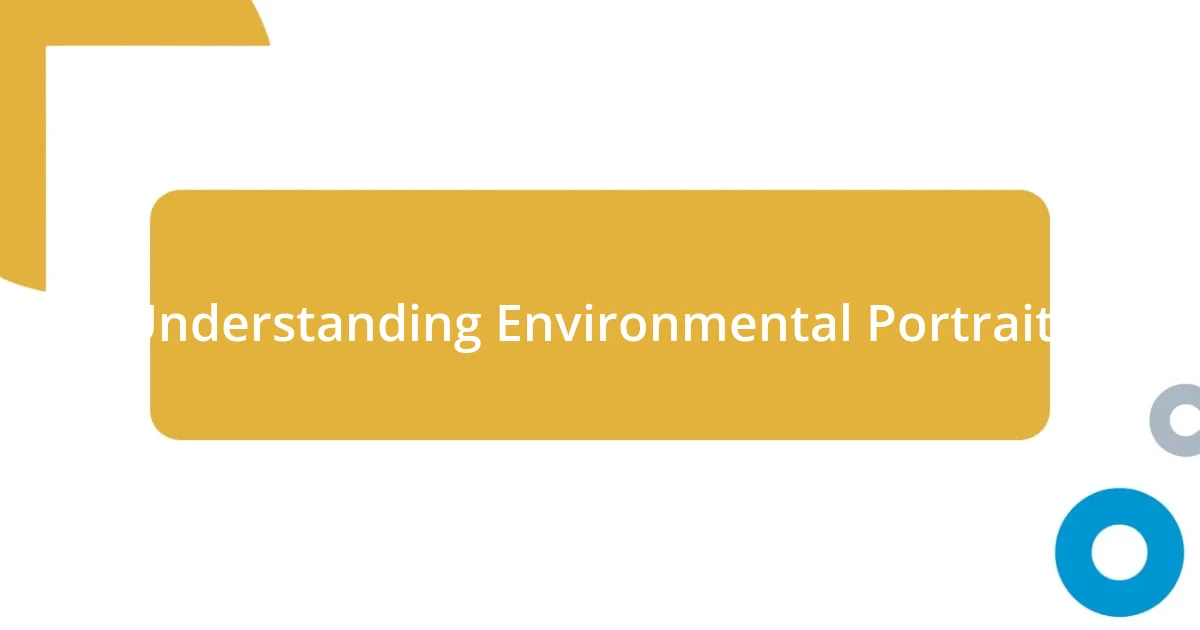
Understanding Environmental Portraits
Environmental portraits are powerful visual narratives that capture not just the subject, but also the context surrounding them. When I took my first environmental portrait at a local bakery, I was struck by how the warm glow of the ovens and the flour-dusted countertops told a story about the life of the baker. Don’t you think that a photograph can speak volumes more than just the person it depicts?
The essence of environmental portraits lies in their ability to showcase the connection between the subject and their surroundings. I remember photographing a musician in his studio, surrounded by instruments and scattered sheets of music. It was fascinating to witness how the clutter reflected his creative process and personality. Isn’t it interesting how these elements can breathe life into the image and create a deeper connection with the viewer?
When crafting an environmental portrait, it’s essential to consider the details that define the subject’s world. During a session with a farmer in his field, I noticed how the rows of crops and the fading light created a perfect backdrop. This environment highlighted his connection to the land, eliciting emotions tied to both hard work and passion. How often do we overlook the small details that can make a significant impact in storytelling?

Choosing the Right Location
Choosing the right location for environmental portraits is akin to finding the perfect stage for a performance. I once chose a bustling café for a shoot, where the lively environment, complete with chattering customers and steaming coffee cups, infused the portraits with energy and authenticity. The ambiance not only set the mood but also illustrated the subject’s passion for connection and community.
Another time, at a serene lakeside, I wanted to capture a quiet introspection in my subject. The soft reflections on the water and the rustling leaves provided a calming backdrop that spoke volumes about their inner world. When selecting a location, I always ask myself how it enhances the narrative—can the viewer feel the subject’s emotions through their surroundings?
In my experience, the best locations are those filled with personal significance for the subject. For instance, I photographed a teacher in her favorite bookshop, surrounded by shelves of stories that inspired her career. The familiarity of the environment created a natural comfort, allowing the true essence of her passion to shine through. It’s these intimate connections that elevate a portrait into something truly special.
| Location Type | Impact on Portrait |
|---|---|
| Café | Creates an energetic, lively atmosphere, reflecting community engagement. |
| Lakeside | Provides tranquility, enhancing introspection and emotion. |
| Bookshop | Showcases personal significance, highlighting the subject’s interests and passions. |
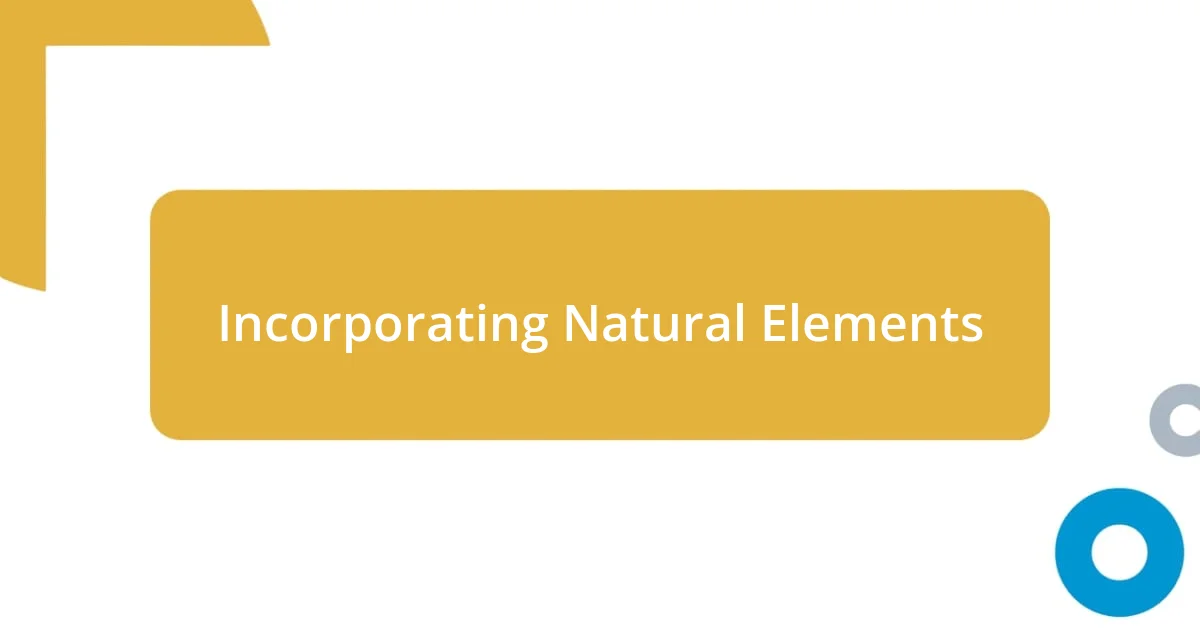
Incorporating Natural Elements
Incorporating natural elements into environmental portraits adds depth and authenticity to the narrative. I vividly remember a shoot I did at a vibrant farmer’s market. The fresh produce, colorful flower stalls, and bustling activity around the farmer added layers to the story. Each fruit and vegetable told a tale of hard work and dedication, enriching the visual experience. I find that bringing in plants, flowers, or even unique textures from the environment helps establish a deeper connection between the subject and their surroundings.
Here are some natural elements to consider including in environmental portraits:
- Trees and Foliage: They create a sense of tranquility and connection to nature.
- Water Features: Like rivers or lakes, which can evoke calmness, reflection, and movement.
- Local Flora: Flowers or plants that resonate with the subject’s personality or profession.
- Natural Light: The play of light and shadow adds mood and depth, enhancing emotional impact.
- Textures: Elements such as wood, stone, or earth can ground the portrait, bringing a tactile quality to the image.
Using these natural components not only enhances the visual appeal but also captures the essence of the subject’s environment, weaving a richer narrative through each shot.
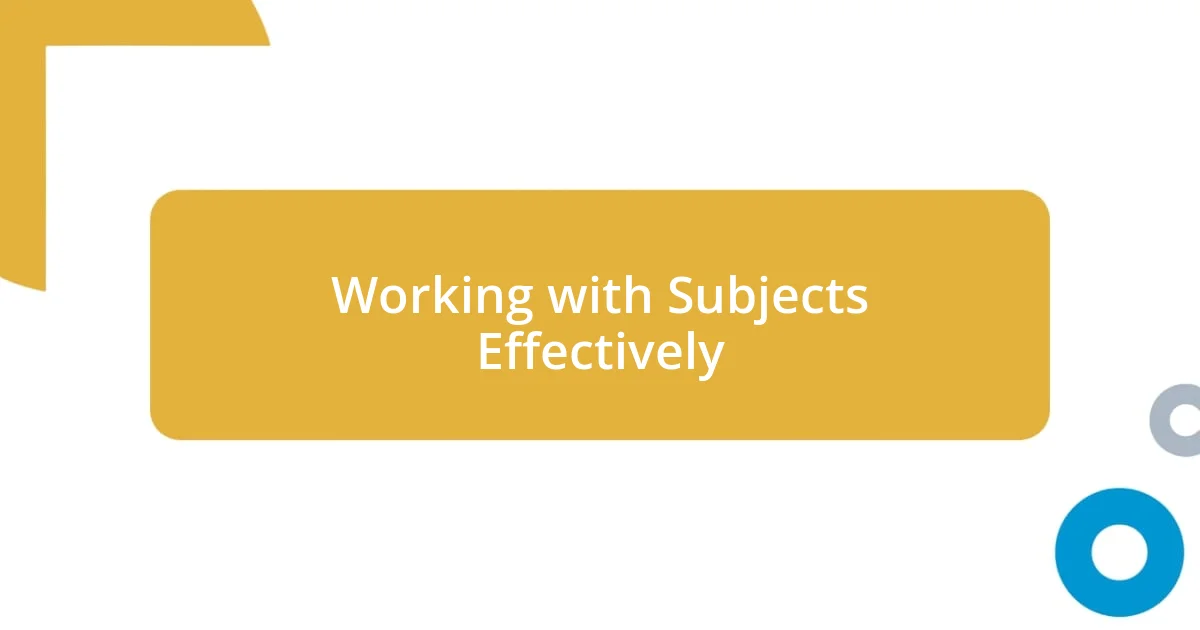
Working with Subjects Effectively
Establishing a genuine rapport with your subjects is essential for capturing their true essence. I remember working with a musician who was initially nervous in front of the camera. By engaging him in conversation about his latest composition—sharing my excitement about his work—I saw his demeanor shift. This connection not only eased his nerves but also allowed me to capture the passion and intensity behind his performance.
Moreover, I’ve found that asking open-ended questions during our time together can reveal surprising layers of personality. For example, while photographing a local chef, I asked about their favorite childhood meal. The nostalgia in their eyes and the stories that unfolded created an authentic, joyous atmosphere. It’s moments like these that translate into powerful photographs, making the viewer feel the story behind the portrait.
Another effective approach is to provide gentle guidance while letting the subject express themselves. I recall a shoot with a young artist who felt overwhelmed with instructions. Encouraging her to pose in ways that felt natural led to spontaneous creativity. This balance between direction and freedom often results in unguarded moments, revealing a side of the subject that is uniquely theirs. Isn’t it fascinating how the right approach can transform an ordinary shoot into a meaningful narrative?
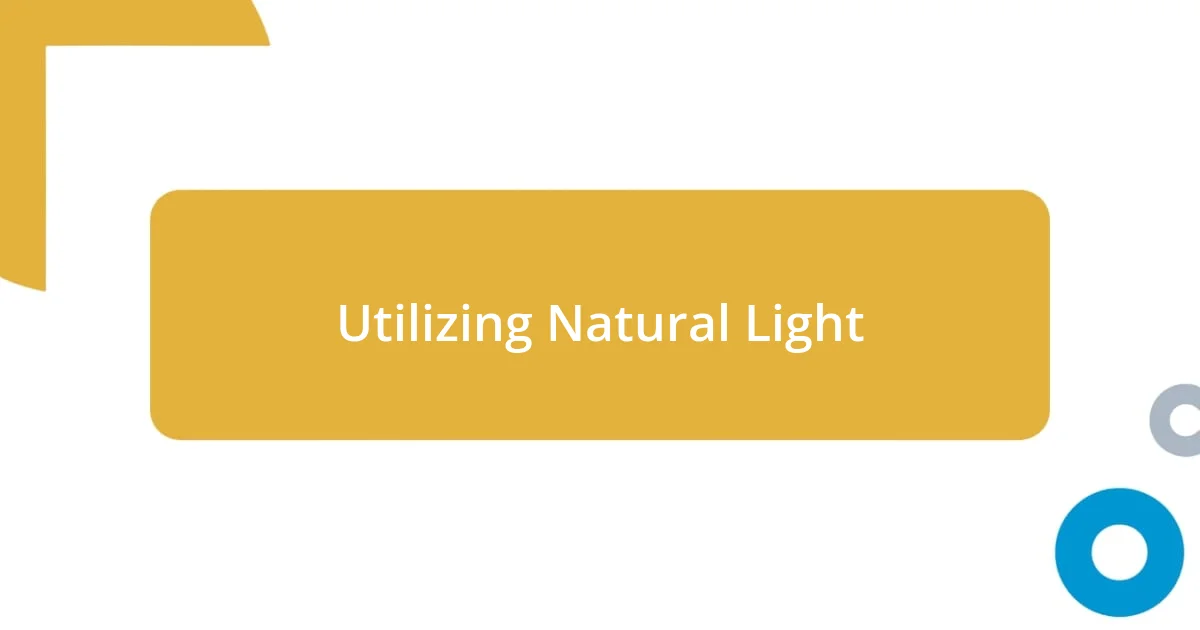
Utilizing Natural Light
Harnessing natural light in environmental portraits is something I truly enjoy. I often seek out golden hour—the time just after sunrise or before sunset—when the light is soft and warm. I remember a shoot on a beach where the low sun cast long shadows across the sand, creating a stunning backdrop for a friend’s portrait. The way the light highlighted her features turned an already beautiful scene into something magical. Isn’t it incredible how the right lighting can transform a simple photograph into a work of art?
I’ve also learned that the positioning of both the subject and myself in relation to the light can dramatically change the mood of a shot. During one memorable session, I had a subject stand near a window with diffused light filtering through sheer curtains. The gentle glow emphasized the intricate details of her expression, adding a touch of intimacy. I find that taking a moment to notice the light’s direction and intensity can provide endless creative possibilities. Have you ever noticed how shadows can tell their own stories within a frame?
Applying these principles can be as simple as adjusting the angle of the subject or changing lenses to capture the interplay of light and shadow. I recall a time when I used a wide-angle lens to embrace my subject in the environment while highlighting the glowing aura of sunlight peeking through trees. The essence of natural light is that it enhances authenticity and brings life to portraits, allowing the connection between the subject and their surroundings to shine. Isn’t that what we all want in a portrait—to feel that real moment captured beautifully?
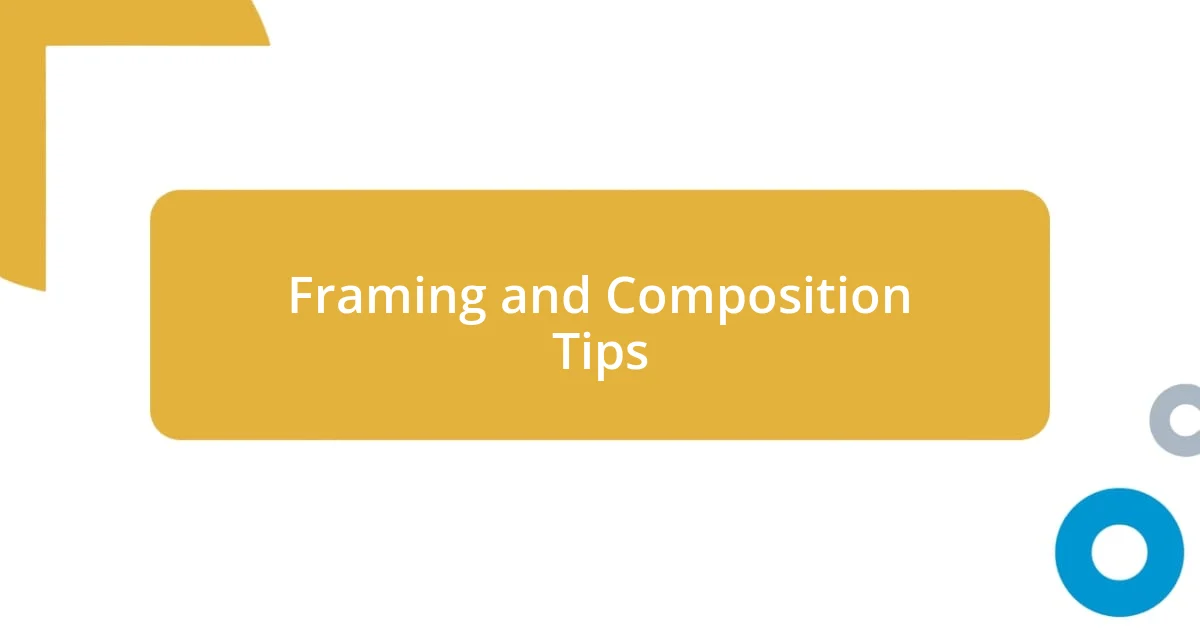
Framing and Composition Tips
When it comes to framing and composition, I find that the rule of thirds is a fantastic guideline to start with. By placing your subject off-center, you can create a more dynamic composition that draws the viewer’s eye. I remember positioning a painter in her studio, aligning her with the grid lines. The added space around her allowed the colorful canvases to complement her presence, turning the image into a delightful conversation between artist and art. Have you ever experimented with this rule? I think it can unlock a whole new visual narrative.
Additionally, leading lines can be incredibly powerful in guiding attention to your subject. In one memorable photo shoot at a local market, I captured a vendor surrounded by vibrant produce. I positioned my camera to utilize the rows of fruits as lines converging towards him. This not only showcased his impact within that lively environment but also made the viewer feel immersed in the scene. It’s amazing how composition can transport you right into the moment, isn’t it?
Lastly, negative space is something I’ve grown to love in my portraits. By leaving areas of the frame intentionally empty, I can emphasize the subject even further. I once photographed a writer at a small café, using the empty surroundings to highlight her focused expression as she penned her thoughts. This approach creates a powerful interplay, allowing viewers to feel the emotion in the space around her. Isn’t that a beautiful way to invite the audience into the story?
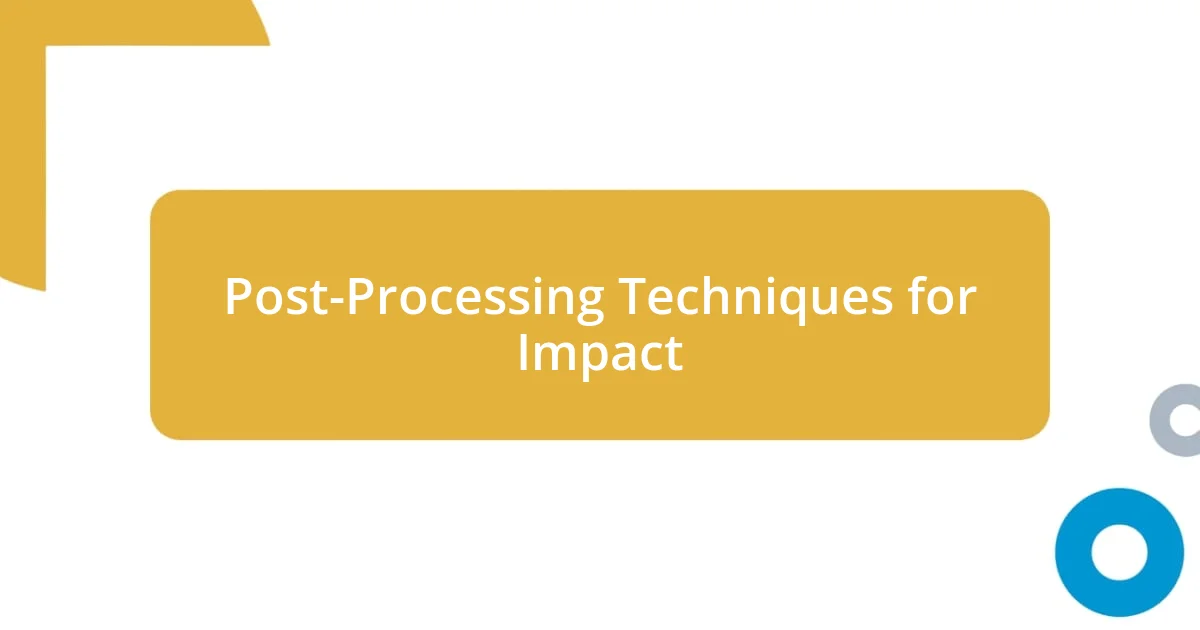
Post-Processing Techniques for Impact
Post-processing techniques play a significant role in enhancing the emotional impact of environmental portraits. I often dive into editing software to adjust colors, contrast, and sharpness, breathing new life into the images. For instance, I remember tweaking the vibrancy of a portrait taken during a foggy morning, enriching the colors of my subject’s coat while maintaining the subtle atmosphere. The final result was a compelling blend of warmth and moodiness—didn’t it seem to evoke a specific feeling as if the viewer was standing there beside her?
Another technique I’ve embraced is selective focus. When I recently edited a shoot where my subject was framed by sweeping greenery, I applied a lens blur effect to the surrounding elements. This approach not only drew attention to her but also encapsulated the feeling of being both connected and isolated in nature. Have you ever experienced that balance? It’s fascinating how a simple edit can transform a shot into a striking narrative, pulling viewers deeper into the story.
Finally, I find that subtle texturing can add depth to an image. On a recent project, I introduced a light grain effect to a portrait of a musician in a dimly lit studio. This seemingly small adjustment not only enhanced the raw emotion of the moment but also created a timeless feel, almost inviting the viewer to engage with the scene more intimately. Isn’t it incredible how the right post-processing choices can elevate an image from good to unforgettable?












